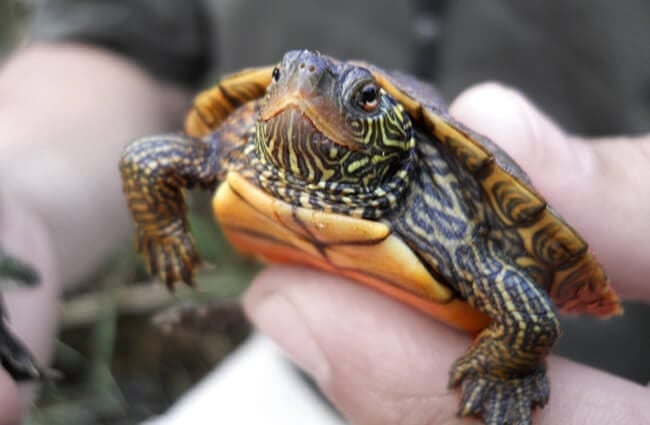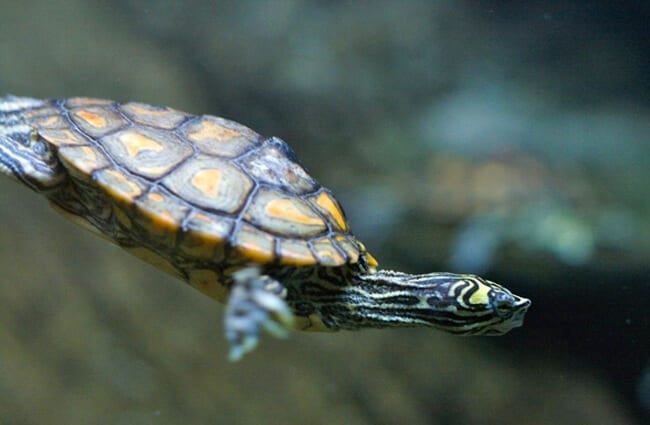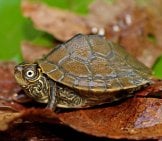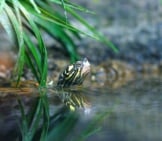A Map Turtle is any species within the taxonomic genus Graptemys. These aquatic reptiles live throughout North America, and researchers recognize 14 different species throughout their range. You can recognize these creatures by looking for their unique shells, which have a distinctly pointed ridge down the back. Read on to learn about the Map Turtle.
Description of the Map Turtle
Each of the 14 species looks slightly different from the next. Their coloration ranges from light green or brown to nearly black. Some species also sport light colored or yellow patterns on their skin or shells.
The different species range in size from about 2.5 inches long at their smallest, to about 12 inches long at their largest. In all species, the males measure about half the size of the females. Larger species can grow up to 5 pounds or more, depending on the individual.
Interesting Facts About the Map Turtle
You can find these turtles primarily in the eastern United States and upwards into parts of Canada. With quite a variety to choose from, learn some of the traits that make these creatures unique below.
- Sawback – These reptiles sport an interesting, and slightly intimidating nickname, “sawback.” Fear not, this name is simply a reference to their unique shell. These creatures have a distinct keel along the top of their shell that resembles the teeth of a saw.
- “Map” Turtle – The “map” in their name also originates from their shell as well. These turtles have light colored markings along their shells that resemble the lines on a map. The lines are easier for you to see when the turtles are young, but this coloration grows darker as they age.
- Sexual Dimorphism – You can tell the difference between males and females of this group by looking for a few specific traits. Researchers refer to this difference as sexual dimorphism. The first thing you’ll notice is the impressive size of the female, because she is twice as large as the male. You will also notice that the male has a longer tail and a sharper keel, or sawback.
- Dormancy – Like all reptiles, these turtles are cold blooded, which means that they heat their bodies by basking in the sun. When the weather gets too chilly for their liking, they lower their heart rate, wedge themselves under a fallen log at the bottom of a lake, and go dormant for a few months.
Habitat of the Map Turtle
These reptiles are aquatic and spend most of their time in watery habitats like lakes, swamps, and ponds. Each species has its own preferences, but most prefer large water bodies with a variety of places to hide and vegetation to forage in.
They also utilize fallen trees and logs to climb out of the water and bask in the sun. These types of features are essential for a good turtle habitat, and you can often find multiple turtles basking on the same log.
Distribution of the Map Turtle
Each species has its own unique distribution, though some populations do overlap with one another. They also vary in the size of their range. Some live across thousands of square miles, while others inhabit just a small region.
All of the various species inhabit North America. Their range extends from southeast Canada throughout the eastern United States and into the southeast United States.
Diet of the Map Turtle
Different species and even different genders feed on different types of prey. All 14 species are omnivorous, which means that they eat both plant and animal matter. Some species rely solely on a few types of prey, while others feed on a wide variety of organisms.
Some of the different things that they hunt include shrimp, crayfish, small crabs, snails, clams, insect larvae, and more. They also eat carrion, typically dead fish.
Map Turtle and Human Interaction
Some people hunt these turtles for food, but this varies in severity based on the species. Humans collect several species for the pet trade. Habitat destruction, pollution, and pesticides all impact these turtles and their prey. This impact varies based on the species.
Domestication
Humans keep some species as pets, but have not domesticated any species of turtle.
Does the Map Turtle Make a Good Pet
Some Map Turtles make good pets. However, it is important that you never take a wild turtle as a pet, and equally important that you never release a pet turtle into the wild.
Map Turtle Care
In a pet or zoological setting, their enclosures should mirror their natural habitat as much as possible. They prefer areas with plenty of water to swim in, a variety of aquatic plants, and several different basking locations.
Their diet varies based on the species and the size of the turtle. You can purchase turtle food, and supplement their diet with small fish, shrimp, and insects.
Behavior of the Map Turtle
These turtles are not outright social, but do not aggressively defend territories. They spend their days alternating between foraging for food, and basking in the sun to warm themselves again. During the wintertime they enter a period of dormancy.
Reproduction of the Map Turtle
Researchers have not studied all of the different species’ breeding habits. Many species reproduce several times in a single year. Females lay their eggs on land, usually in sandy areas near the water. It takes anywhere from two to three months for the eggs to hatch.
When the young turtles hatch, they do not receive any type of parental care. Different species reach sexual maturity at different rates. For most, it takes several years before the young turtles can reproduce.











![Red Angus Closeup of a beautiful Red Angus cowPhoto by: U.S. Department of Agriculture [pubic domain]https://creativecommons.org/licenses/by/2.0/](https://animals.net/wp-content/uploads/2020/03/Red-Angus-4-238x178.jpg)












![Red Angus Closeup of a beautiful Red Angus cowPhoto by: U.S. Department of Agriculture [pubic domain]https://creativecommons.org/licenses/by/2.0/](https://animals.net/wp-content/uploads/2020/03/Red-Angus-4-100x75.jpg)

